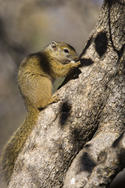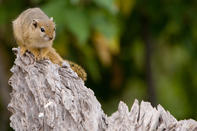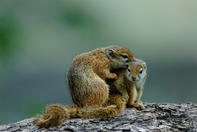Up and Down

Although squirrels nest and overnight in trees, they are as much terrestrial (ground-dwelling) as they are arboreal (tree-dwelling) when it comes to foraging.
They spend a large portion of the day on the ground picking up seeds, the occasional insect, and eating grass.
While they forage they are cautious and walk in a jerky manner often with their tails flicking nervously.
Tree squirrels forage alone and must rely on their own vigilance to keep them alive.
Their sense of hearing and sight are both acute and given even the slightest provocation, the squirrel will bound into the safety of a nearby tree.
They take cover in tree holes or lie flat against a branch.
They often circle the trunk of the tree keeping the threat on the opposite side of the trunk to itself. If need be, tree squirrels can scamper between trees very rapidly bounding easily across 2 m gaps.
Dextrous and Agile

Tree squirrels are extremely dextrous and manipulate tiny objects like seeds with expert skill. They routinely hang from their hind legs to reach food just out of arm's reach or they may even jump and grab repeating the procedure until the item is obtained.
They may clamber over the flimsiest of branches to access fruits. Squirrels usually sit in an elevated position while they feed to enable them to look out for danger at the same time.
Squirrel it Away

Tree squirrels are diurnal and forage during daylight hours only. They are most busy during the cooler mornings and afternoon periods and generally, they will rest up during the heat of the day.
Tree squirrels do cache food supplies to be used at a later time but their pantries are never quite as substantial as European squirrels.
They dig small holes into which they deposit seeds and other food debris and then pat the soil down with their chins. This is always done in private but none-the-less food thieving is still commonplace among squirrels.
By Megan Emmett